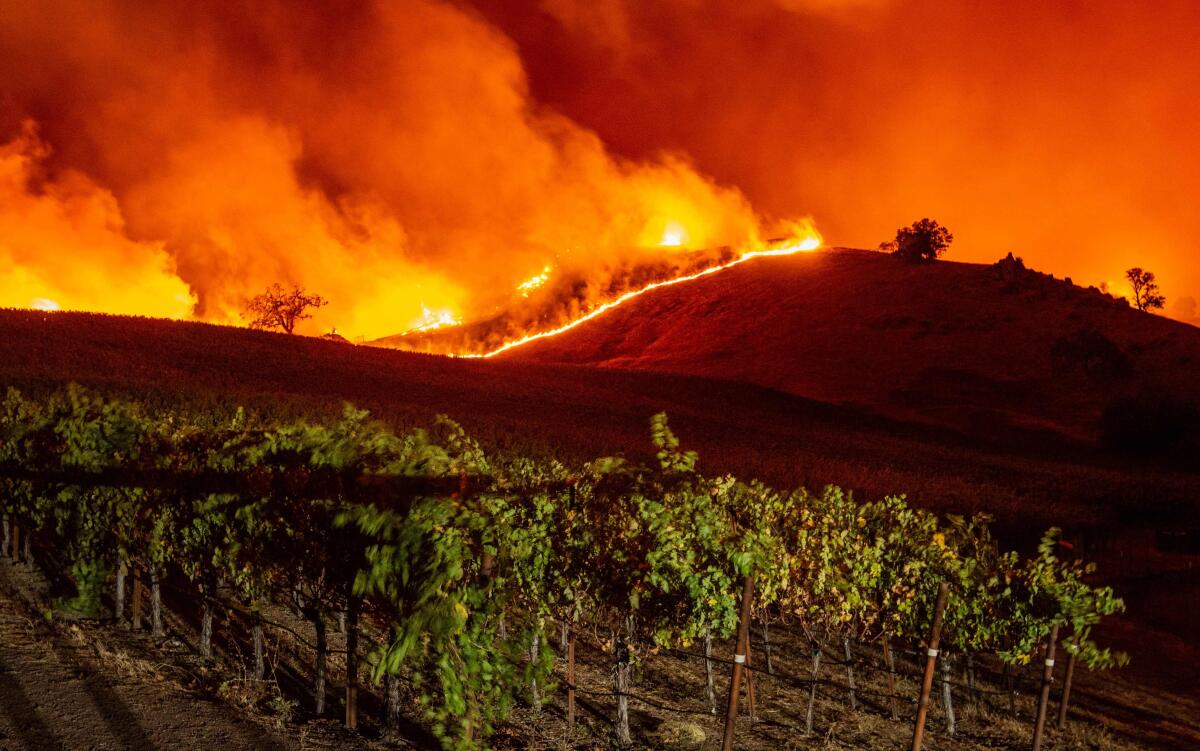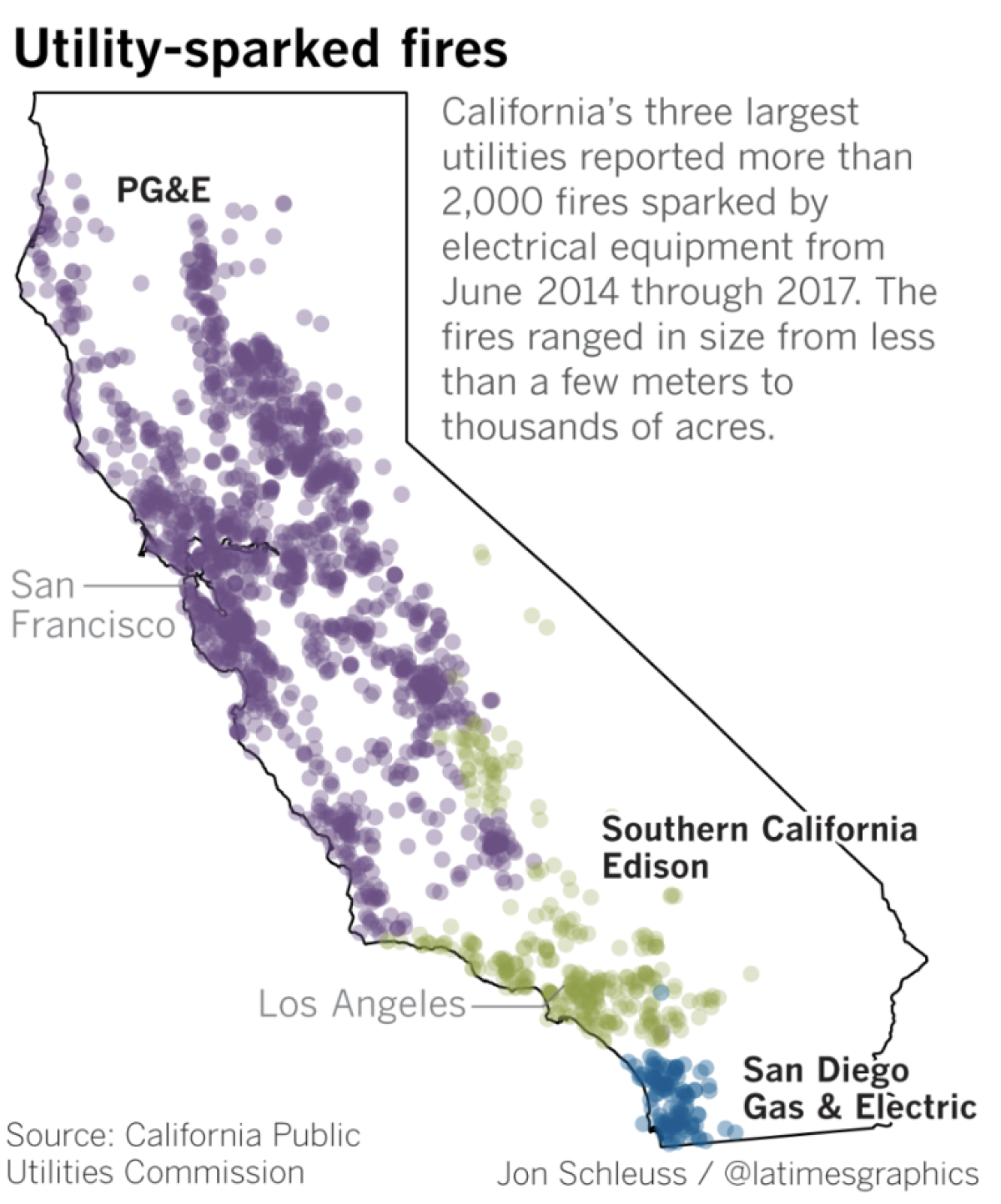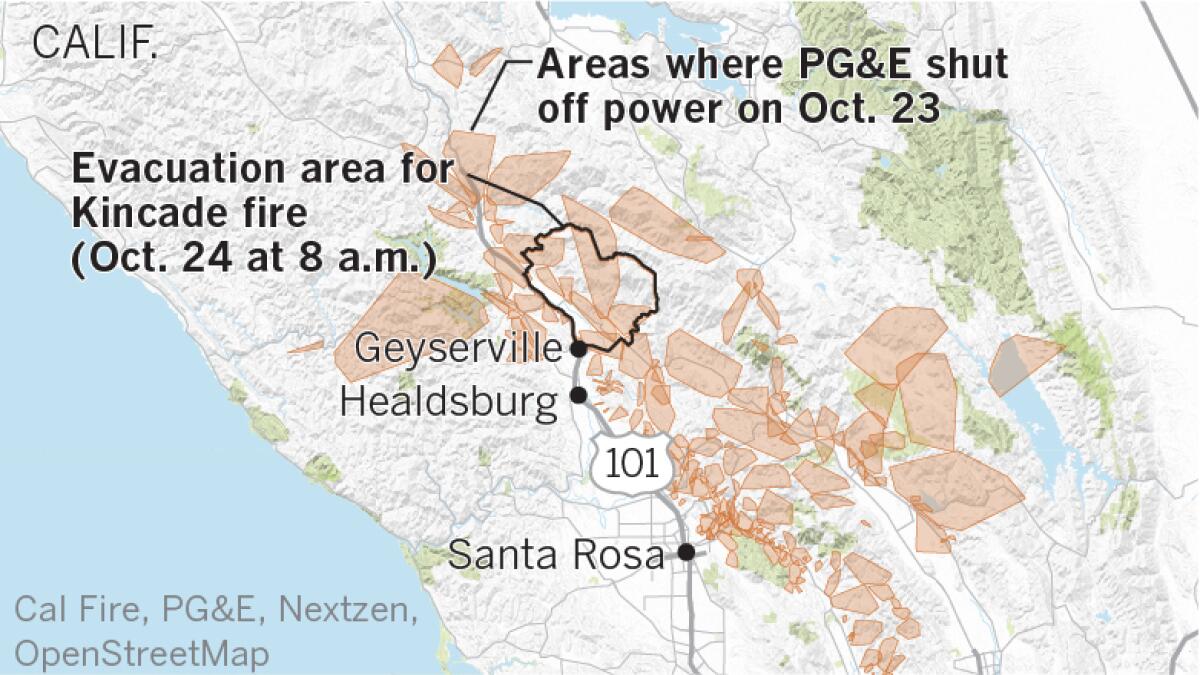Did PG&E power lines cause the destructive Kincade fire? Here is what we know

- Share via
Pacific Gas & Electric faced widespread criticism earlier this month when it shut off power to big swaths of Northern California when powerful winds moved in.
Those blackouts occurred without any major wildfires caused by downed power lines.
This week, PG&E shut off power again as winds returned, but to fewer customers.
Now, there are questions about whether a utility line might have sparked a major fire in Sonoma County.
Here is what we know:
Q: Do we know what caused the Kincade fire?
No, the cause is still under investigation. And it will likely take months for fire investigators to determine what sparked the blaze, which has burned 21,900 acres in northern Sonoma County and destroyed dozens of structures. The fire is only 5% contained.

Q: So why is PG&E under scrutiny again?
PG&E said Thursday that transmission lines experienced problems Wednesday night around the area where the fire broke out.
In a mandatory report sent to the California Public Utilities Commission, the company said one of its workers noticed that the California Department of Forestry and Fire Protection had taped off the area. PG&E said Cal Fire also pointed out a “broken jumper on the same tower.”
PG&E had been shutting off power to residents to avoid fires sparked by electric lines. The utility company said nearly 28,000 people in Sonoma County, including Geyserville and the surrounding area, lost power when distribution lines were shut off at 3 p.m. Wednesday. The company said transmission lines, which operate at a higher voltage, remained energized at the time the fire started.
Transmission lines generally carry electricity from power plants to substations. Distribution lines deliver power directly to homes and businesses.
News of the line issues caused PG&E stock price to fall 25% Friday.

Q: Are utility line malfunctions a major cause of wildfires?
Equipment malfunctions have been tied to some of the state’s most destructive and deadliest fires, including last year’s Camp fire — which devastated the town of Paradise in Northern California and killed 85 people — and the 2017 wine country blazes.
Liability from those fires pushed PG&E into bankruptcy earlier this year.
Scores of lawsuits have been filed on behalf of people whose loved ones were killed, whose pets disappeared into the blazing wilderness and who lost everything they owned. They accuse the utility of failing to properly maintain its equipment.
The Times reported earlier this year that equipment owned by California’s three largest utilities ignited more than 2,000 fires in three and a half years.
PG&E reported 1,552 equipment-related fires from June 2014 through the end of 2017. Southern California Edison, the electricity supplier for 15 million people mostly south of Fresno County, reported 347 fires in that time. Serving a 4,100-square-mile area from San Clemente to the Mexican border, San Diego Gas & Electric disclosed 115 fires in the time period.
Investigators determined last year that Edison power lines ignited the 2017 Thomas fire, a massive blaze in Ventura and Santa Barbara counties that killed two people. Officials are still trying to determine whether power lines sparked last November’s Woolsey fire, which ripped through Ventura County and Malibu.
Q: So what is next?
PG&E’s CEO has warned that power outages designed to prevent fires could continue for years.
“I think this is probably a 10-year timeline to get to a point where it’s really ratcheted down significantly,” Chief Executive William D. Johnson told regulators last week.
The CEO said PG&E was working to make the blackout zones more precise in the wake of criticism.
Johnson laid out a long list of measures the utility has undertaken to improve its handling of future shutoffs, while limiting their duration. He said the utility would gradually “sectionalize” equipment, so it could power down smaller sections of the grid at a time and there would also need to be more local power generation. Covered transmission wire would help, as well as better “vegetation management” and evolving technology, he said.
Such efforts would take years to complete, he predicted.
How about this weekend?
This weekend’s planned power outages could be the largest yet in California.
PG&E, which has 5.4 million electric customers and provides power to 16 million Californians, was projecting Thursday that it could shut off power across nearly all of its territory in Northern California on Sunday and Monday because of ferocious gusts.
“This system will likely be the strongest event of the year from a wind perspective,” the utility said on its website. “Federal forecast agencies are in alignment that this will be a high-risk weather event.”
More to Read
Sign up for Essential California
The most important California stories and recommendations in your inbox every morning.
You may occasionally receive promotional content from the Los Angeles Times.














